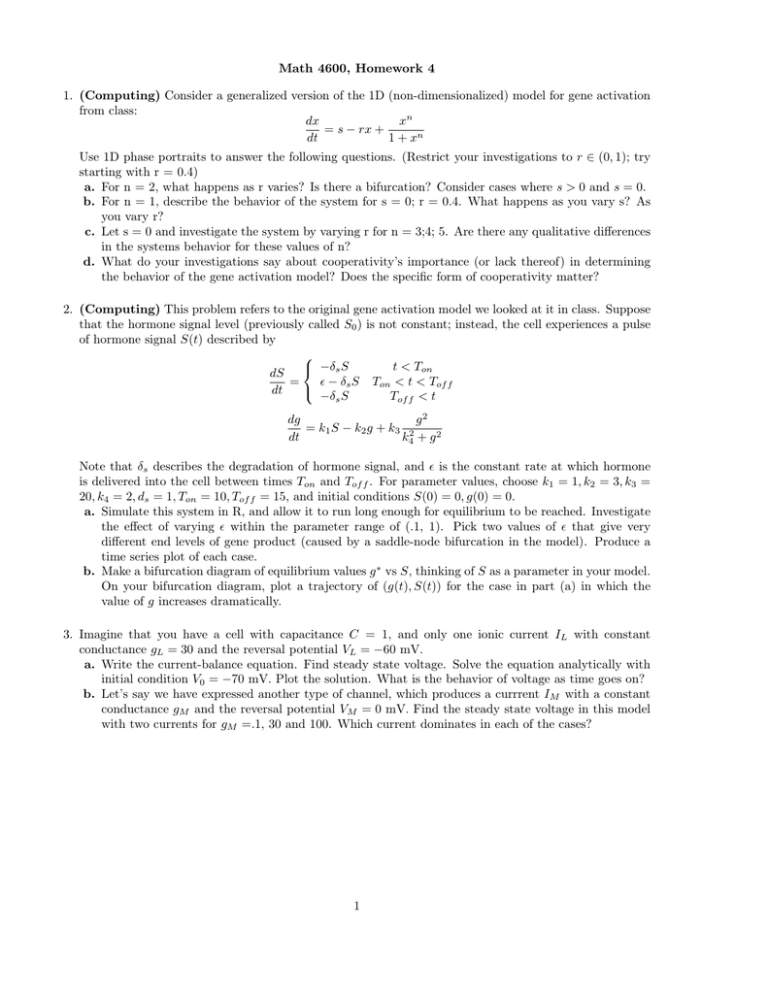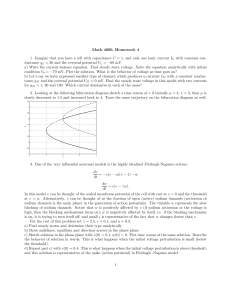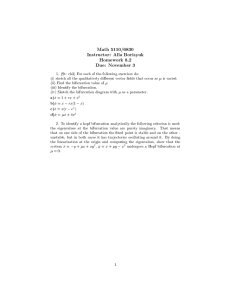Math 4600, Homework 4
advertisement

Math 4600, Homework 4 1. (Computing) Consider a generalized version of the 1D (non-dimensionalized) model for gene activation from class: dx xn = s − rx + dt 1 + xn Use 1D phase portraits to answer the following questions. (Restrict your investigations to r ∈ (0, 1); try starting with r = 0.4) a. For n = 2, what happens as r varies? Is there a bifurcation? Consider cases where s > 0 and s = 0. b. For n = 1, describe the behavior of the system for s = 0; r = 0.4. What happens as you vary s? As you vary r? c. Let s = 0 and investigate the system by varying r for n = 3;4; 5. Are there any qualitative differences in the systems behavior for these values of n? d. What do your investigations say about cooperativity’s importance (or lack thereof) in determining the behavior of the gene activation model? Does the specific form of cooperativity matter? 2. (Computing) This problem refers to the original gene activation model we looked at it in class. Suppose that the hormone signal level (previously called S0 ) is not constant; instead, the cell experiences a pulse of hormone signal S(t) described by t < Ton −δs S dS − δs S Ton < t < Tof f = dt −δs S Tof f < t dg g2 = k1 S − k2 g + k3 2 dt k4 + g 2 Note that δs describes the degradation of hormone signal, and is the constant rate at which hormone is delivered into the cell between times Ton and Tof f . For parameter values, choose k1 = 1, k2 = 3, k3 = 20, k4 = 2, ds = 1, Ton = 10, Tof f = 15, and initial conditions S(0) = 0, g(0) = 0. a. Simulate this system in R, and allow it to run long enough for equilibrium to be reached. Investigate the effect of varying within the parameter range of (.1, 1). Pick two values of that give very different end levels of gene product (caused by a saddle-node bifurcation in the model). Produce a time series plot of each case. b. Make a bifurcation diagram of equilibrium values g ∗ vs S, thinking of S as a parameter in your model. On your bifurcation diagram, plot a trajectory of (g(t), S(t)) for the case in part (a) in which the value of g increases dramatically. 3. Imagine that you have a cell with capacitance C = 1, and only one ionic current IL with constant conductance gL = 30 and the reversal potential VL = −60 mV. a. Write the current-balance equation. Find steady state voltage. Solve the equation analytically with initial condition V0 = −70 mV. Plot the solution. What is the behavior of voltage as time goes on? b. Let’s say we have expressed another type of channel, which produces a currrent IM with a constant conductance gM and the reversal potential VM = 0 mV. Find the steady state voltage in this model with two currents for gM =.1, 30 and 100. Which current dominates in each of the cases? 1
![Bifurcation theory: Problems I [1.1] Prove that the system ˙x = −x](http://s2.studylib.net/store/data/012116697_1-385958dc0fe8184114bd594c3618e6f4-300x300.png)





